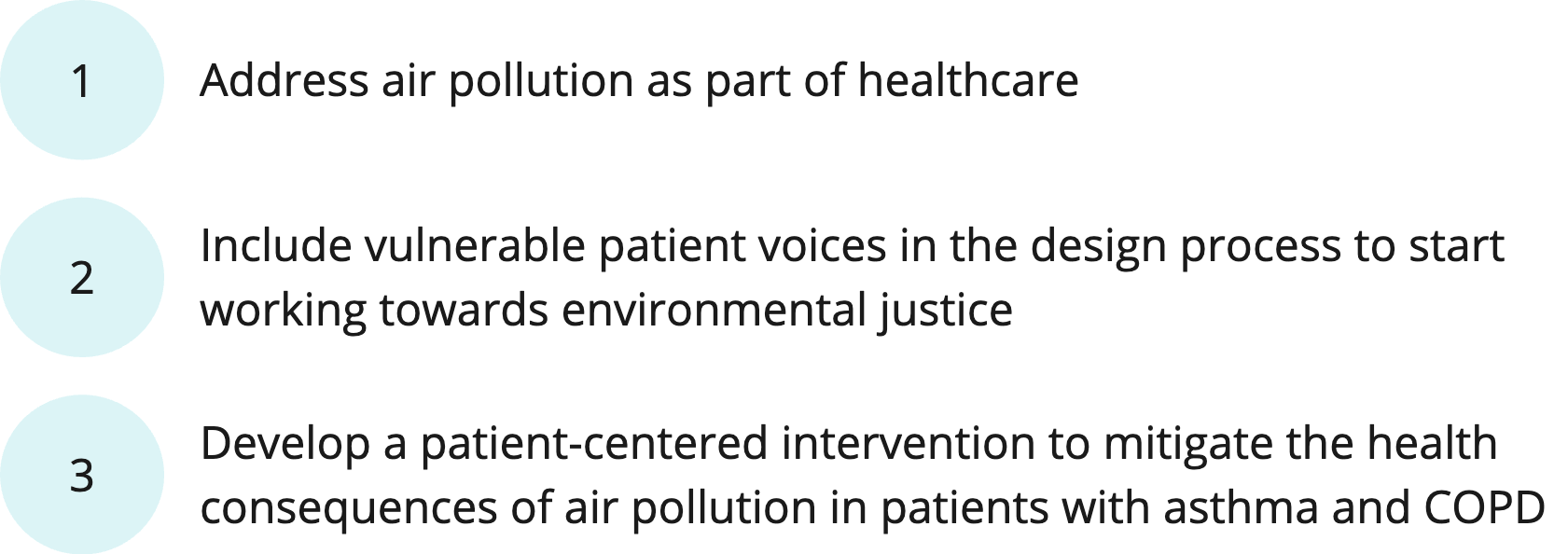Addressing Air Pollution as a Health System
-
Challenge
Develop a health system intervention to help patients with asthma and chronic obstructive pulmonary disease manage their illness when air pollution levels are high, inclusive of vulnerable patient populations
-
Outcome
A text alert system synced to the electronic health record to help patients get treatment when they are at high risk for exacerbations
Process
This project was born out of several groups at UCLA Health wanting to address the impacts of climate on health as a healthcare system. The concept was special because work on climate and health that directly involves patients is in its infancy. Our goals were to:
Setting the Stage: Context and Constraints
I received a UCLA Equity, Diversity, and Inclusion Innovation Award to lead our effort, using human-centered design processes to work with care teams and patients with asthma and COPD. The interplay between air pollution and health is complex, so we started by thinking in systems about how air pollution ultimately reaches patients and impacts relevant health measures. We considered the different modifiers to air pollution and health, and which we had the greatest capacity to influence.
We also knew that our project would have important constraints. The team agreed to “get the ball rolling” to reach patients sooner and give us the opportunity to learn on the go. While there would be potential to apply for grants or establish external partnerships with greater scope in the future, we would work with the means that were readily available. This meant that for now the intervention would:
be an internal intervention within UCLA Health
not require additional employees
be fluid with existing clinical workflows
Stakeholder Discovery
Given the interdisciplinary nature of air pollution and health, we expected the project would interface with many different people throughout the UCLA Health System and community. Gathering both buy-in and input from relevant stakeholders groups was important to ensure the intervention was relevant and considerate of different needs.
Interdisciplinary Ideation and Sacrificial Concepts
We had folks from all of these stakeholder groups work together in a series of discussions and brainstorms. At this divergent stage, we stayed open-minded about the kind of intervention we might develop. Below are some of the groupings of ideas that came from these sessions.
Equitable by Design
We wanted our design choices to reflect the patient populations who bear the disproportionate health burden of air pollution, so we set the standard for at least 50% of participants to be people of color, on Medicaid, or low-income. This was interesting because this breakdown does not reflect the general UCLA Health patient population. Compiling an inclusive participant group is not enough to develop equitable solutions, but I think it is a necessary step to start.
7
People of Color
4
People under 200% federal poverty level
2
People on Medicaid
4
People over age 75
We also needed to acknowledge that while our goal was to help vulnerable patient groups most impacted by air pollution in Los Angeles, the safety net hospitals and county systems see a higher volume of these patient groups than UCLA. Los Angeles healthcare is fragmented into many hospitals and health systems, but we know that addressing health equity and environmental justice ultimately needs to be a common mission.
Primary Design Research
I led different types of interviews with care team members and patients with asthma and chronic obstructive pulmonary disease, hearing their stories and gaining their input to refine our concepts. After simmering on those conversations and talking through themes, we synthesized what we learned into insights.
From these insights, we hashed out the most essential components of our intervention, or the design requirements.
Pilot Prototype
With patient and care team members, we revised our sacrificial concepts and converged on one lead concept that could influence the most modifiers of air pollution and health. In the text alert concept, patients would receive text alerts from UCLA Health when air quality would exacerbate their lung disease coupled with ways to act and access healthcare. This connection to their pulmonologist’s office distinguishes this concept from general air quality alerts.
We are now working with the Information Services and Solutions team to develop the intervention within our electronic health system and preparing for pilot rollout. This has led to a new divergent phase to the project, as we fold in the data and informatics potential of UCLA Health.





